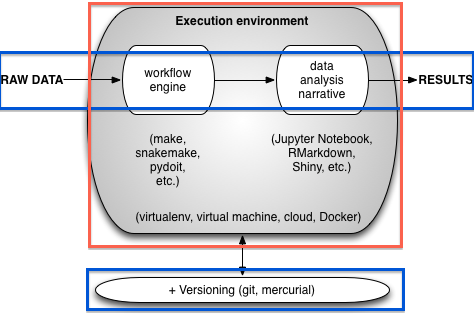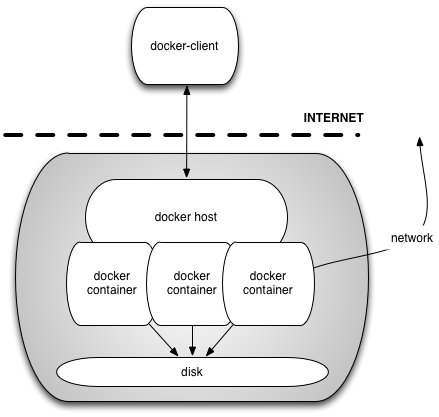Running in a container environment¶
Learning objectives: learn about Docker containers, and how they can help deal with dependencies.
Note
To go through the following, you’ll need to have Docker installed. For most of it, you’ll also need to have an Amazon Web Services account.
(This is an abbreviated & focused version of a 2-day Docker workshop that I ran at UC BIDS; see the full notes)
Introduction: dependencies, and containers¶
If you think back to our original overview, we’ve got three of the four workflow components in place - we’ve got a workflow that takes our raw data and converts it into a summary, we’ve got an analysis notebook that generates results from that data, and we’ve put it in git.

But, in order to run it, we still need a lot of things installed. In this case, we don’t have that weird a stack of software: we need Python, make, Jupyter Notebook, and wordcloud - which depends on numpy and matplotlib. Not terribly.
But, hypothetically, we could have many dependencies - for example, bioinformatic workflows often involve dozens of dependencies, with things written in Java and Ruby and Perl and ...
Installing all of these dependencies on your own laptop may be difficult enough, but it becomes nearly impossible in shared environments like lab workstations and HPCs, where you generally don’t have admin/install privileges, and where you have to be concerned about conflicts between dependencies because it’s a shared environment.
This is where isolated environments come in. These allow you to install a collection of software in such away that it only interacts within that collection.
There’s a bunch of ways to do this, ranging from language-specific (virtualenv in Python) to whole-machine (virtual machines and cloud).
Docker containers are a new-ish way to do this. Docker basically provides a lightweight virtual machine that is quick and easy to start up, and the Docker ecosystem includes ways of specifying configurations and also shipping these fully configured “containers” around.
A super quick introduction to Docker¶
Before Getting Started¶
Can you run this?
docker run hello-world
and see something like this?
Hello from Docker.
...
If that works, you should do:
docker pull ubuntu:14.04
If that doesn’t work, you might need to run this to reset your local docker install:
docker-machine restart default && eval "$(docker-machine env default)"
Getting started¶
Try:
docker run ubuntu:14.04 /bin/echo 'Hello world'
Now try:
docker run -it ubuntu:14.04 /bin/bash
Q: What does the ‘-it’ do?
Points to cover:
- you can use CTRL-D or type ‘exit’ to leave the container
- “images” are the disk, “containers” are the running bit
Try creating a file in your container; first run:
docker run -it ubuntu:14.04 /bin/bash
and then inside the docker container run:
echo hello, there > /home/foo.txt
Now, exit the container. Make note of the container ID if you can - it’s the string right after ‘root@’ and before the ‘:’, and should be something like ‘003eafc0422c’.
First, if you run ‘docker run ubuntu:14.04 -it /bin/bash’ you will see that the file is not there:
cat /home/foo.txt
This is because every container starts fresh from the base image (here, ubuntu:14.04).
However, you can still access files from old containers (unless you specify ‘–rm’ when you run things). Here,
docker cp 003eafc0422c:/home/foo.txt .
will copy the file into your current directory.
So: data is transient, unless you make other provisions (we’ll talk about this later!)
You can get a list of running containers by doing:
docker ps
You can get a list of all containers (running and stopped) by doing:
docker ps -a
You can get a list of all images by doing:
docker images
You can remove a container with ‘docker rm’, and remove an image with ‘docker rmi’. The
Two handy commands to clean up (a) stopped containers and (b)
docker rm $(docker ps -a -q)
docker rmi $(docker images | grep "^<none>" | awk "{print $3}")
Using docker-machine to run Docker on AWS¶
Documentation: https://docs.docker.com/machine/; also see Amazon Web Services driver docs
Here, we’re going to use Amazon to host and run our Docker images, while controlling it from our local machine.

Start by logging into the AWS EC2 console.
Find your AWS credentials and your VPC ID.
your AWS credentials are here, and if you haven’t used them before you may need to “Create a New Access Key”. (Be sure not to store these in a place that other people can view them.)
Your AWS
to get your VPC ID, go into https://console.aws.amazon.com/vpc/home and select “Your VPCs”. Your VPC ID should look something like vpc-9efe1afa (that’s mine and won’t work for you ;)
Then, set your AWS_KEY and AWS_SECRET and VPC_ID; on Linux/Mac, fill in the values and execute:
export AWS_KEY=
export AWS_SECRET=
export VPC_ID=
...not sure what to do on Windows, maybe build the command below in a text editor?
Then, run:
docker-machine create --driver amazonec2 --amazonec2-access-key ${AWS_KEY} \
--amazonec2-secret-key ${AWS_SECRET} --amazonec2-vpc-id ${VPC_ID} \
--amazonec2-zone b --amazonec2-instance-type m3.xlarge \
aws
and to connect to it, do:
eval $(docker-machine env aws)
and now you can run all the ‘docker’ commands as you would expect, EXCEPT that your docker host is now running Somewhere Else.
If you have trouble getting a subnet, make sure that your VPC has subnets in the zone/region you’re trying to use. You can set these with:
--amazonec2-region "us-east-1" --amazonec2-zone b
Take a look at the help for the EC2 driver here:
docker-machine create --driver amazonec2 -h | less
Things to discuss:
- diagram out what we’re doing!
- docker-machine manages your docker host; docker manages your containers/images ON that host.
- talk about AWS host sizes/instance types: https://aws.amazon.com/ec2/instance-types/
- explain docker client, docker host, docker container relationship
- also include -p, -v discussion.
—
You can use ‘docker-machine stop aws’ and ‘docker-machine start aws’ to stop and start this machine; with AWS, you will need to do a ‘docker-machine regenerate-certs aws’ after starting it in order to connect to it with docker-machine env.
To kill the machine, do ‘docker-machine kill aws’. This will also, I believe, trash the configuration settings so you would need to reconfigure it with a ‘create’.
Note that while the machine is running or stopped, you should be able to see it at the AWS EC2 console.
Let’s talk more about why you would want to do this :).
Also, diagrams!
Building your own Docker image (by writing a Dockerfile)¶
On your local machine, create a new (empty) directory called ‘wordcloud-image’. In that directory, create a file ‘Dockerfile’ that contains:
FROM jupyter/notebook
RUN apt-get update && apt-get -y install python-matplotlib python-numpy \
unzip
and then execute:
docker build -t wordcloud-image .
Now run it:
docker run -it -p 9000:8888 wordcloud-image
and in the docker container you should be able to execute your entire workflow from within the notebook:
In the terminal,
- check out your source code;
- change into the directory;
- run make;
In the notebook,
- run the notebook analysis.
Some final points on Docker¶
Docker is a decent solution for “single chassis” compute, where you can run everything on one computer.
Docker:
- gives you a consistent environment - either static OR procedurally generated;
- lets you move compute to the data;
- it also gives you a way to run anonymous or encapsulated compute.
but:
- it’s not declarative (you can’t computationally analyze all Dockerfiles without just running them);
- you run the risk of just dumping everything into a binary blog that provides no insight or remixability.
You can read some more thoughts on Docker (and mybinder) here:
Return to index: Welcome to the 2016 #uioCarpentry Oslo workshop on Reproducibility
LICENSE: This documentation and all textual/graphic site content is licensed under the Creative Commons - 0 License (CC0) -- fork @ github. Presentations (PPT/PDF) and PDFs are the property of their respective owners and are under the terms indicated within the presentation.